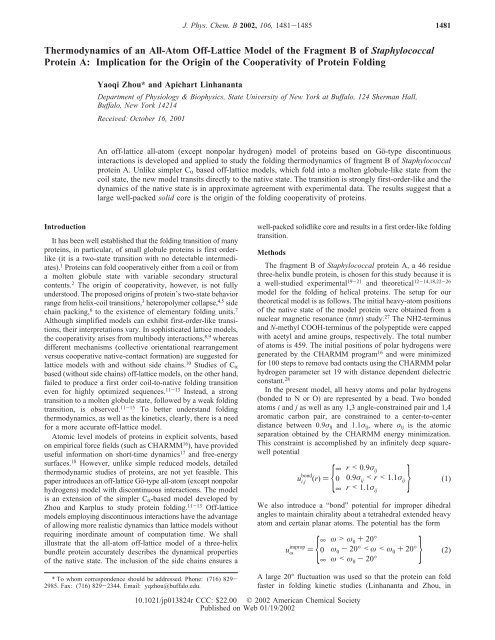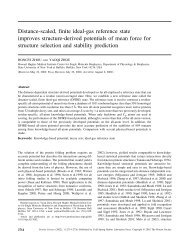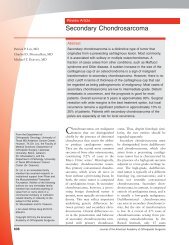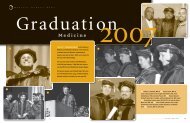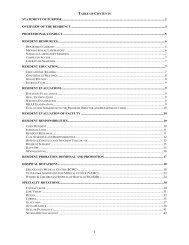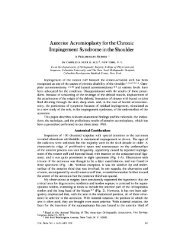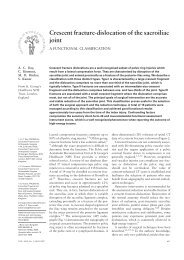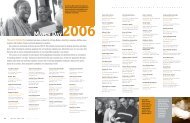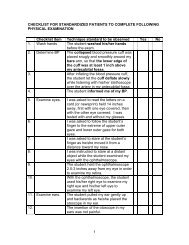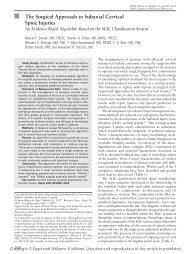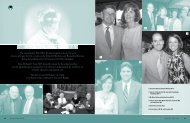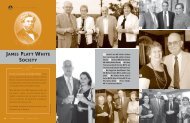Thermodynamics of an All-Atom Off-Lattice Model ... - Yaoqi Zhou Lab
Thermodynamics of an All-Atom Off-Lattice Model ... - Yaoqi Zhou Lab
Thermodynamics of an All-Atom Off-Lattice Model ... - Yaoqi Zhou Lab
You also want an ePaper? Increase the reach of your titles
YUMPU automatically turns print PDFs into web optimized ePapers that Google loves.
J. Phys. Chem. B 2002, 106, 1481-1485<br />
1481<br />
<strong>Thermodynamics</strong> <strong>of</strong> <strong>an</strong> <strong>All</strong>-<strong>Atom</strong> <strong>Off</strong>-<strong>Lattice</strong> <strong>Model</strong> <strong>of</strong> the Fragment B <strong>of</strong> Staphylococcal<br />
Protein A: Implication for the Origin <strong>of</strong> the Cooperativity <strong>of</strong> Protein Folding<br />
<strong>Yaoqi</strong> <strong>Zhou</strong>* <strong>an</strong>d Apichart Linh<strong>an</strong><strong>an</strong>ta<br />
Department <strong>of</strong> Physiology & Biophysics, State UniVersity <strong>of</strong> New York at Buffalo, 124 Sherm<strong>an</strong> Hall,<br />
Buffalo, New York 14214<br />
ReceiVed: October 16, 2001<br />
An <strong>of</strong>f-lattice all-atom (except nonpolar hydrogen) model <strong>of</strong> proteins based on Goj-type discontinuous<br />
interactions is developed <strong>an</strong>d applied to study the folding thermodynamics <strong>of</strong> fragment B <strong>of</strong> Staphylococcal<br />
protein A. Unlike simpler C R based <strong>of</strong>f-lattice models, which fold into a molten globule-like state from the<br />
coil state, the new model tr<strong>an</strong>sits directly to the native state. The tr<strong>an</strong>sition is strongly first-order-like <strong>an</strong>d the<br />
dynamics <strong>of</strong> the native state is in approximate agreement with experimental data. The results suggest that a<br />
large well-packed solid core is the origin <strong>of</strong> the folding cooperativity <strong>of</strong> proteins.<br />
Introduction<br />
It has been well established that the folding tr<strong>an</strong>sition <strong>of</strong> m<strong>an</strong>y<br />
proteins, in particular, <strong>of</strong> small globule proteins is first orderlike<br />
(it is a two-state tr<strong>an</strong>sition with no detectable intermediates).<br />
1 Proteins c<strong>an</strong> fold cooperatively either from a coil or from<br />
a molten globule state with variable secondary structural<br />
contents. 2 The origin <strong>of</strong> cooperativity, however, is not fully<br />
understood. The proposed origins <strong>of</strong> protein’s two-state behavior<br />
r<strong>an</strong>ge from helix-coil tr<strong>an</strong>sitions, 3 heteropolymer collapse, 4,5 side<br />
chain packing, 6 to the existence <strong>of</strong> elementary folding units. 7<br />
Although simplified models c<strong>an</strong> exhibit first-order-like tr<strong>an</strong>sitions,<br />
their interpretations vary. In sophisticated lattice models,<br />
the cooperativity arises from multibody interactions, 8,9 whereas<br />
different mech<strong>an</strong>isms (collective orientational rearr<strong>an</strong>gement<br />
versus cooperative native-contact formation) are suggested for<br />
lattice models with <strong>an</strong>d without side chains. 10 Studies <strong>of</strong> C R<br />
based (without side chains) <strong>of</strong>f-lattice models, on the other h<strong>an</strong>d,<br />
failed to produce a first order coil-to-native folding tr<strong>an</strong>sition<br />
even for highly optimized sequences. 11-13 Instead, a strong<br />
tr<strong>an</strong>sition to a molten globule state, followed by a weak folding<br />
tr<strong>an</strong>sition, is observed. 11-15 To better underst<strong>an</strong>d folding<br />
thermodynamics, as well as the kinetics, clearly, there is a need<br />
for a more accurate <strong>of</strong>f-lattice model.<br />
<strong>Atom</strong>ic level models <strong>of</strong> proteins in explicit solvents, based<br />
on empirical force fields (such as CHARMM 16 ), have provided<br />
useful information on short-time dynamics 17 <strong>an</strong>d free-energy<br />
surfaces. 18 However, unlike simple reduced models, detailed<br />
thermodynamic studies <strong>of</strong> proteins, are not yet feasible. This<br />
paper introduces <strong>an</strong> <strong>of</strong>f-lattice Goj-type all-atom (except nonpolar<br />
hydrogens) model with discontinuous interactions. The model<br />
is <strong>an</strong> extension <strong>of</strong> the simpler C R -based model developed by<br />
<strong>Zhou</strong> <strong>an</strong>d Karplus to study protein folding. 11-13 <strong>Off</strong>-lattice<br />
models employing discontinuous interactions have the adv<strong>an</strong>tage<br />
<strong>of</strong> allowing more realistic dynamics th<strong>an</strong> lattice models without<br />
requiring inordinate amount <strong>of</strong> computation time. We shall<br />
illustrate that the all-atom <strong>of</strong>f-lattice model <strong>of</strong> a three-helix<br />
bundle protein accurately describes the dynamical properties<br />
<strong>of</strong> the native state. The inclusion <strong>of</strong> the side chains ensures a<br />
well-packed solidlike core <strong>an</strong>d results in a first order-like folding<br />
tr<strong>an</strong>sition.<br />
Methods<br />
The fragment B <strong>of</strong> Staphylococcal protein A, a 46 residue<br />
three-helix bundle protein, is chosen for this study because it is<br />
a well-studied experimental 19-21 <strong>an</strong>d theoretical 12-14,18,22-26<br />
model for the folding <strong>of</strong> helical proteins. The setup for our<br />
theoretical model is as follows. The initial heavy-atom positions<br />
<strong>of</strong> the native state <strong>of</strong> the model protein were obtained from a<br />
nuclear magnetic reson<strong>an</strong>ce (nmr) study. 27 The NH2-terminus<br />
<strong>an</strong>d N-methyl COOH-terminus <strong>of</strong> the polypeptide were capped<br />
with acetyl <strong>an</strong>d amine groups, respectively. The total number<br />
<strong>of</strong> atoms is 459. The initial positions <strong>of</strong> polar hydrogens were<br />
generated by the CHARMM program 16 <strong>an</strong>d were minimized<br />
for 100 steps to remove bad contacts using the CHARMM polar<br />
hydrogen parameter set 19 with dist<strong>an</strong>ce dependent dielectric<br />
const<strong>an</strong>t. 28<br />
In the present model, all heavy atoms <strong>an</strong>d polar hydrogens<br />
(bonded to N or O) are represented by a bead. Two bonded<br />
atoms i <strong>an</strong>d j as well as <strong>an</strong>y 1,3 <strong>an</strong>gle-constrained pair <strong>an</strong>d 1,4<br />
aromatic carbon pair, are constrained to a center-to-center<br />
dist<strong>an</strong>ce between 0.9σ ij <strong>an</strong>d 1.1σ ij , where σ ij is the atomic<br />
separation obtained by the CHARMM energy minimization.<br />
This constraint is accomplished by <strong>an</strong> infinitely deep squarewell<br />
potential<br />
{∞ r < 0.9σ ij<br />
}<br />
u bond i,j (r) ) 0 0.9σ ij < r < 1.1σ ij (1)<br />
∞ r < 1.1σ ij<br />
We also introduce a “bond” potential for improper dihedral<br />
<strong>an</strong>gles to maintain chirality about a tetrahedral extended heavy<br />
atom <strong>an</strong>d certain pl<strong>an</strong>ar atoms. The potential has the form<br />
{∞ ω > ω 0 + 20°<br />
}<br />
u improp ω ) 0 ω 0 - 20° < ω < ω 0 + 20° (2)<br />
∞ ω < ω 0 - 20°<br />
* To whom correspondence should be addressed. Phone: (716) 829-<br />
2985. Fax: (716) 829-2344. Email: yqzhou@buffalo.edu.<br />
A large 20° fluctuation was used so that the protein c<strong>an</strong> fold<br />
faster in folding kinetic studies (Linh<strong>an</strong><strong>an</strong>ta <strong>an</strong>d <strong>Zhou</strong>, in<br />
10.1021/jp013824r CCC: $22.00 © 2002 Americ<strong>an</strong> Chemical Society<br />
Published on Web 01/19/2002
1482 J. Phys. Chem. B, Vol. 106, No. 6, 2002 <strong>Zhou</strong> <strong>an</strong>d Linh<strong>an</strong><strong>an</strong>ta<br />
Figure 1. (a) Ribbon representation <strong>of</strong> the global minimum structure <strong>of</strong> <strong>an</strong> all-atom <strong>of</strong>f-lattice model <strong>of</strong> the fragment B <strong>of</strong> Staphylococcal protein<br />
A. The atomic positions are indicated by linked sticks which represent atomic bonds. (b) Inst<strong>an</strong>t<strong>an</strong>eous structure at T* ) 4.0. A small helical<br />
segment is visible along the coil. These residual helical contents are const<strong>an</strong>tly being formed <strong>an</strong>d broken at high temperature. Drawn using Molscript. 47<br />
preparation). A smaller value will lead to a weaker folding<br />
tr<strong>an</strong>sition but will not affect the overall results presented here.<br />
The improper <strong>an</strong>gles ω are identified by using the CHARMM<br />
19 parameter set. 16 In eq 2, ω 0 ) 35.264 39° for chiralconstrained<br />
atoms (such as <strong>an</strong> R carbon without explicit<br />
hydrogens) <strong>an</strong>d ω 0 ) 0° for pl<strong>an</strong>ar-constrained atoms (such as<br />
improp<br />
a carbonyl carbon). The improper dihedral potential u ω<br />
preserves the L-form chirality <strong>of</strong> amino acids <strong>an</strong>d mimics some<br />
<strong>of</strong> the rigidity <strong>of</strong> peptide units. A nonbonded i,j pair interacts<br />
by a hard-core <strong>an</strong>d square-well potential<br />
{∞ r < 0.8σ ij<br />
}<br />
VdW<br />
u i,j (r) ) B ij ɛ 0.8σ VdW VdW<br />
ij < r < 1.2σ ij (3)<br />
VdW<br />
0 r > 1.2σ ij<br />
where σ VdW<br />
ij are the v<strong>an</strong> der Waals parameters from the<br />
CHARMM polar hydrogen parameter set 19 28 <strong>an</strong>d B ij is the yetto-be-determined<br />
interaction strength. The factor <strong>of</strong> 0.8 for the<br />
hard-core diameters is typical for ratio between the diameter <strong>of</strong><br />
a hard-sphere reference system <strong>an</strong>d the v<strong>an</strong> der Waals parameter<br />
found in the Week-Ch<strong>an</strong>dler-Andersen perturbation theory, 29<br />
whereas a ratio <strong>of</strong> 1.5 between the square-well <strong>an</strong>d hard-core<br />
diameters is typical for systems <strong>of</strong> small molecules. 30<br />
Initial hard-core overlaps in the CHARMM minimized<br />
structure are removed by a short discontinuous molecular<br />
dynamics (DMD) simulation during which the square-well<br />
interactions for the contacts found in the NMR structure are set<br />
to -100. A large negative energy is used to ensure that the<br />
original native contacts are maintained during the process <strong>of</strong><br />
removing overlapping contacts. The initial hard-core diameter<br />
between <strong>an</strong>y two overlapped atoms is set to the dist<strong>an</strong>ce between<br />
the atoms found in the energy-minimized structure. The hardcore<br />
diameters are adjusted at each time step until the corresponding<br />
actual diameters are reached <strong>an</strong>d the simulation is<br />
continued until all initial overlaps are removed. The resulting<br />
structure has a root-me<strong>an</strong>-squared deviation (rmsd) from the<br />
NMR averaged structure <strong>of</strong> only 0.70 Å <strong>an</strong>d is employed as<br />
the global minimum structure for the model (Figure 1a). Helix<br />
I (H1) includes residue 2 to 11, Helix II includes residue 16 to<br />
30, <strong>an</strong>d Helix III includes residue 33 to 47. In all, there are<br />
3381 square-well atom-atom overlaps (including both backbone<br />
<strong>an</strong>d side chain contacts) in the global minimum structure.<br />
Henceforth, these shall be referred to as native contacts.<br />
AGoj interaction 31 is employed to ensure that the energy <strong>of</strong><br />
the native structure shown in Figure 1a is at the global minimum.<br />
InaGoj model, a square-well overlap between two atoms results<br />
in <strong>an</strong> interaction energy <strong>of</strong> - ɛ(B ij )-1) for a native contact<br />
<strong>an</strong>d0(B ij ) 0) otherwise. We use the Goj model because the<br />
native topology was found to play a domin<strong>an</strong>t role in the folding<br />
rate <strong>an</strong>d the folding tr<strong>an</strong>sition state <strong>of</strong> small fast-folding<br />
proteins. 11-13,32-36 Henceforth, the internal energy, E*() E/ɛ),<br />
<strong>an</strong>d temperature, T* () k B T/ɛ), are scaled in units <strong>of</strong> ɛ.<br />
The DMD simulations for the isolated model protein are<br />
performed in a c<strong>an</strong>onical ensemble. Const<strong>an</strong>t temperature is<br />
maintained by collisions with ghost-solvent particles. The<br />
algorithm <strong>an</strong>d implementation <strong>of</strong> DMD are described in earlier<br />
publications. 12,37 The initial configurations, in all runs, are set<br />
to the global minimum structure. The initial velocities are<br />
r<strong>an</strong>domly generated from a Maxwell-Boltzm<strong>an</strong>n distribution.<br />
The simulations are performed for a total <strong>of</strong> at least 500 million<br />
<strong>an</strong>d up to 1.4 billion collisions near phase tr<strong>an</strong>sition. Equilibration<br />
periods <strong>of</strong> between one hundred to two hundred million<br />
collisions, depending on temperature, are allowed before data<br />
collection. Simulations are conducted at T* ) 1.0,1.2, 1.5, 1.7,<br />
2.0, 2.2, 2.4, 2.6, 2.8, 3.0, 3.1, 3.2, 3.3, 3.4, 3.5, 3.6, 3.8, 4.0,<br />
4.2, 4.4, 4.6, 4.8, <strong>an</strong>d 5.0. Five independent runs with different<br />
initial velocities are performed at each temperature to estimate<br />
errors.<br />
Results <strong>an</strong>d Discussion<br />
The DMD simulations show that for reduced temperature T*<br />
< 3.3, the protein assumes a low-energy nativelike structure<br />
(Figure 1a), whereas for T* > 3.6 the protein rapidly unfolds<br />
(in as little as 10 million collisions) to a high-energy coillike<br />
state with tr<strong>an</strong>sient helical segments (Figure 1b). In Figure 2a<br />
the reduced heat capacity, C v / () C v /k B ), <strong>an</strong>d internal energy,<br />
E*, are plotted as a function <strong>of</strong> reduced temperature, T*. The
Origin <strong>of</strong> the Cooperativity <strong>of</strong> Protein Folding J. Phys. Chem. B, Vol. 106, No. 6, 2002 1483<br />
Figure 2. (a) Reduced heat capacity (C / V ) <strong>of</strong> the all-atom model as a<br />
function <strong>of</strong> reduced temperature. (b) The reduced energy (E*) <strong>of</strong> the Figure 4. Reduced heat capacity (C / V ), (a), <strong>an</strong>d the reduced energy<br />
all-atom model as a function <strong>of</strong> the reduced temperature. The strong (E*), (b), <strong>of</strong> the C R based model 12 as a function <strong>of</strong> reduced temperature.<br />
fluctuation <strong>of</strong> C /<br />
V near the tr<strong>an</strong>sition temperature is due to the The results are for a Goj interaction with the bias gap g ) 1 <strong>of</strong> Ref. 12.<br />
coexistence <strong>of</strong> the coil <strong>an</strong>d folded states.<br />
Three C V peaks from right to left shown in (a) correspond to the collapse<br />
tr<strong>an</strong>sition from coil to molten globule, the folding tr<strong>an</strong>sition from molten<br />
globule to surface-molten solid, <strong>an</strong>d the surface-molten solid to solid<br />
tr<strong>an</strong>sition.<br />
Figure 3. Population distribution at the tr<strong>an</strong>sition temperature (T* )<br />
3.35) obtained by the weighted-histogram method. 43,37<br />
sigmoidal increase in E* in a very narrow T* r<strong>an</strong>ge from 3.3 to<br />
3.6, <strong>an</strong>d the sharp peak in C v / at T* ) 3.35 suggest a strong<br />
first order-like tr<strong>an</strong>sition. Indeed, weighted-histogram <strong>an</strong>alysis<br />
at the tr<strong>an</strong>sition temperature T* ) 3.35 shows a bimodal<br />
population distribution (Figure 3) indicating a two-state tr<strong>an</strong>sition.<br />
The tr<strong>an</strong>sition is accomp<strong>an</strong>ied by a large increase in the<br />
radius <strong>of</strong> gyration from about 10.5 Å to about 20.0 Å.<br />
It is <strong>of</strong> interest to compare the C R model developed by <strong>Zhou</strong><br />
<strong>an</strong>d Karplus 12,13 with the all-atom model proposed here; both<br />
employed discontinuous Goj interactions. The global minimum<br />
structure <strong>of</strong> the C R model was also optimized to yield a threehelix<br />
bundle structure similar to Fragment B <strong>of</strong> Staphylococcal<br />
protein A. The global minimum energy for the 46-bead model<br />
is -254ɛ. The number <strong>of</strong> square-well contacts per bead is 5.5,<br />
which is much smaller th<strong>an</strong> 7.4 for the all-atom model. This<br />
suggests that the all-atom model is a lot more compact th<strong>an</strong> the<br />
simple backbone model.<br />
Figure 4 shows the reduced heat capacity <strong>an</strong>d energy as a<br />
function <strong>of</strong> reduced temperature for the C R three-helix bundle. 12,13<br />
The single tr<strong>an</strong>sition observed for the all-atom model is replaced<br />
by multiple tr<strong>an</strong>sitions that correspond to coil to molten globule,<br />
Figure 5. Root-me<strong>an</strong>-squared fluctuation as function <strong>of</strong> residue index<br />
from the model calculation (open squares) is compared with that from<br />
the 10 NMR model structures (filled circles). 27<br />
molten globule to surface-molten solid (native), <strong>an</strong>d frozen<br />
tr<strong>an</strong>sition. 11-13 Because the global minimum energy <strong>of</strong> the allatom<br />
model is about a factor <strong>of</strong> 10 lower th<strong>an</strong> that <strong>of</strong> the C R<br />
model, a simple scaling suggests that the single tr<strong>an</strong>sition at T*<br />
) 3.35 for the all-atom model corresponds to the folding<br />
tr<strong>an</strong>sition at T* ) 0.3 for the 46-bead model. That is, the<br />
all-atom model protein folds directly from coil to the native<br />
state.<br />
To verify that the protein is in the native state below the<br />
tr<strong>an</strong>sition temperature, structural <strong>an</strong>d dynamical <strong>an</strong>alysis is<br />
performed at T* ) 3.0. The rmsd from the NMR structure is<br />
only 2.5 Å for all heavy atoms <strong>an</strong>d 1.9 Å for the main chain<br />
atoms. Similar rmsd values were obtained in <strong>an</strong> all-atom<br />
simulation <strong>of</strong> fragment B <strong>of</strong> protein A in explicit water<br />
solvent. 25 Figure 5 compares the root-me<strong>an</strong>-squared fluctuations<br />
(rmsf) <strong>of</strong> the model with the rmsf <strong>of</strong> the 10 NMR model<br />
structures. 27 The correlation coefficient <strong>of</strong> 0.68 between the two
1484 J. Phys. Chem. B, Vol. 106, No. 6, 2002 <strong>Zhou</strong> <strong>an</strong>d Linh<strong>an</strong><strong>an</strong>ta<br />
Figure 6. Generalized Lindem<strong>an</strong>n disorder parameter (∆ L in (r cut)) as a<br />
function <strong>of</strong> the dist<strong>an</strong>ce from the geometrical center, r cut <strong>of</strong> the protein.<br />
Five independent runs at T* ) 3.0 are shown in the figure.<br />
sets <strong>of</strong> data shows that the all-atom model c<strong>an</strong> reproduce, to <strong>an</strong><br />
acceptable degree <strong>of</strong> accuracy, the atomic fluctuations <strong>of</strong> a<br />
protein.<br />
The dynamics <strong>of</strong> the native state c<strong>an</strong> be characterized by the<br />
Lindem<strong>an</strong>n parameter, ∆ L . 38 For <strong>an</strong> inhomogeneous system, we<br />
define the generalized Lindem<strong>an</strong>n parameter ∆ L in (r cut ) 39,40<br />
<br />
∆ in L (r cut ) ) ∑<br />
(∆ i L ) 2<br />
〈∆r 2 i 〉<br />
i,r i
Origin <strong>of</strong> the Cooperativity <strong>of</strong> Protein Folding J. Phys. Chem. B, Vol. 106, No. 6, 2002 1485<br />
(7) Murphy, K. P.; Freire, E. AdV. Protein Chem. 1992, 43, 313-361.<br />
(8) Kolinski, A.; Galazka, W.; Skolnick, J. Proteins 1996, 26, 271-<br />
287.<br />
(9) Kaya, H.; Ch<strong>an</strong>, H. S. Phys. ReV. Lett. 2000, 85, 4823-4826.<br />
(10) Hao, M. H.; Scheraga, H. A. J. Mol. Biol. 1998, 277, 973-983.<br />
(11) <strong>Zhou</strong>, Y.; Karplus, M. Proc. Natl. Acad. Sci. U.S.A. 1997, 94,<br />
14 429-14 432.<br />
(12) <strong>Zhou</strong>, Y.; Karplus, M. J. Mol. Biol. 1999b, 293, 917-951.<br />
(13) <strong>Zhou</strong>, Y.; Karplus, M. Nature 1999a, 401, 400-403.<br />
(14) P<strong>an</strong>de, V. S.; Rokhsar, D. S. Proc. Natl. Acad. Sci. U.S.A. 1998,<br />
95, 1490-1494.<br />
(15) Guo, Z. Y.; Brooks, III, C. L. Biopolymers 1997, 42, 745-757.<br />
(16) Brooks, B. R.; Bruccoleri, R. E.; Olafson, B. D.; States, D. J.;<br />
Swaminath<strong>an</strong>, S.; Karplus, M. J. Comput. Chem. 1983, 4, 187-217.<br />
(17) McCammon, J. A.; Gelin, B. R.; Karplus, M. Nature 1977, 267,<br />
585-590.<br />
(18) Boczko, E. M.; Brooks, C. L., III Science 1995, 269, 393-396.<br />
(19) Cedergren, L.; Andersson, R.; J<strong>an</strong>sson, B.; Uhlen, M.; Nilsson, B.<br />
Prot. Eng. 1993, 6, 441-448.<br />
(20) Bottomley, S. P.; Popplewell, A. G.; Scawen, M.; W<strong>an</strong>, T.; Sutton,<br />
B. J.; Gore, M. G. Protein Eng. 1994, 7, 1463-1470.<br />
(21) Bai, Y. W.; Karimi, A.; Dyson, H. J.; Wright, P. E. Protein Sci.<br />
1997, 6, 1449-1457.<br />
(22) Takada, S.; Luthey-Schulten, Z.; Wolynes, P. G. J. Chem. Phys.<br />
1999, 110, 11 616-11 629.<br />
(23) Guo, Z. Y.; Brooks, III, C. L.; Boczko, E. M. Proc. Natl. Acad.<br />
Sci. (USA) 1997, 94, 10 161-10 166.<br />
(24) Takada, S. Porteins 2001, 42, 85-98.<br />
(25) Alonso, D. O. V.; Daggett, V. Proc. Natl. Acad. Sci. (USA) 2000,<br />
97, 133-138.<br />
(26) Kolinski, A.; Skolnick, J. Proteins. 1994, 18, 353-366.<br />
(27) Gouda, H.; Torigoe, H.; Saito, A.; Sato, M.; Arata, Y.; Shimada, I.<br />
Biochemistry 1992, 31, 9665-9672.<br />
(28) Neria, E.; Fischer, S.; Karplus, M. J. Chem. Phys. 1996, 105, 1902-<br />
1921.<br />
(29) Weeks, J. D.; Ch<strong>an</strong>dler, D.; Andersen, H. C. J. Chem. Phys. 1971,<br />
54, 5237-5247.<br />
(30) Sherwood, A. E.; Prausnitz, J. M. J. Chem. Phys. 1964, 41, 429-<br />
437.<br />
(31) Taketomi, H.; Ueda, Y.; Goj, N.Int. J. Peptide <strong>an</strong>d Protein Res.<br />
1975, 7, 445-459.<br />
(32) Martinez, J. C.; Serr<strong>an</strong>o, L. Nature Struct. Biol. 1999, 6, 1010-<br />
1016.<br />
(33) Riddle, D. S.; Gr<strong>an</strong>tcharova, V. P.; S<strong>an</strong>tiago, J. V.; Alm, E.;<br />
Ruczinski, I.; Baker, D. Nature Struct. Biol. 1999, 6, 1016-1024.<br />
(34) Muñoz, V.; Eaton, W. A. Proc. Natl Acad. Sci. (USA) 1999, 96,<br />
11 311-11 316.<br />
(35) Takada, S. Proc. Natl. Acad. Sci. (USA) 1999, 96, 11 698-11 700.<br />
(36) Baker, D. Nature 2000, 405, 39-42.<br />
(37) <strong>Zhou</strong>, Y.; Karplus, M.; Wichert, J. M.; Hall, C. K. J. Chem. Phys.<br />
1997, 107, 10 691-10 708.<br />
(38) Lindem<strong>an</strong>n, F. A. Physik. Z. 1910, 11, 609-612.<br />
(39) Stillinger, F. H.; Stillinger, D. K. J. Chem. Phys. 1990, 93, 6013-<br />
6024.<br />
(40) <strong>Zhou</strong>, Y.; Vitkup, D.; Karplus, M. J. Mol. Biol. 1999, 285, 1371-<br />
1375.<br />
(41) Löwen, H. Phys. Rep. 1994, 237, 249-324.<br />
(42) Stillinger, F. H. Science 1995, 267, 1935-1939.<br />
(43) Ferrenberg, A. M.; Swendsen, R. H. Phys. ReV. Lett. 1989, 63,<br />
1195-1197.<br />
(44) <strong>Zhou</strong>, Y.; Hall, C. K.; Karplus, M. Phys. ReV. Lett. 1996, 77, 2822-<br />
2825.<br />
(45) Kunz, R. E.; Berry, R. S. Phys. ReV. Lett. 1993, 71, 3987.<br />
(46) Kauzm<strong>an</strong>n, W. AdV. Protein Chem. 1959, 14, 1-63.<br />
(47) Kraulis, P. J. Applied Cryst. 1991, 24, 946-950.<br />
(48) Shimada, J.; Kussell, E. L.; Shakhnovich, E. I. J. Mol. Biol. 2000,<br />
308, 79-95.


